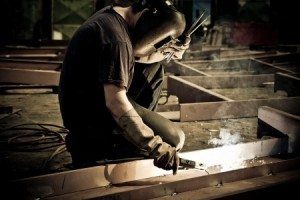
| Updated February 4, 2020If you’re a welder, chances are you’ve encountered distortion or shrinkage on a project. The science behind this is relatively easy to understand but undeniably frustrating.
When a weld cools to room temperature, it shrinks. The adjacent cold base metal prevents this from happening, resulting in what is called ‘residual tensile stress’. Think of it like a rubber band that has been stretched out. Once you remove the clamps holding the work piece, the base metal springs back, ultimately distorting the part. As a weld shrinks across a piece’s width, it causes groove welds to “wing-up”, and as a weld shrinks along its length, the base metal begins to twist around the weld itself.
Here are some ideas for minimizing weld distortion on your next welding project. While it can’t be prevented in full, there are ways to keep it under control.
Avoid overwelding. The bigger the weld project, the bigger the distortion. By accurately measuring the weld, you can minimize distortion, and save yourself time and material costs.
Alternate the welding sequence. Planning out your welding sequence can save you a lot of time and energy. By placing weld metal at different points of your assembly, you can help assure the structure shrinks in one place, counteracting shrinkage from welds that already have been made. An example: Welding alternatively on either side of a neutral axis, while making a joint penetration groove in a butt joint.
Clamping. Tools that hold pieces into a desired position, and keep them there until a weld is finished, are the most well-known tools for controlling shrinkage. Unfortunately, there will always be some movement, but it will be much lower than if you used no clamps at all.
Balance welds around the neutral axis. By welding on both sides of the plate, you will offset one shrinkage force with another. In turn, you will see less distortion on your project.
These are just a few suggestions for keeping shrinkage at a minimum on your next welding project. Happy welding!